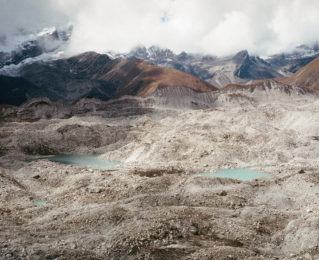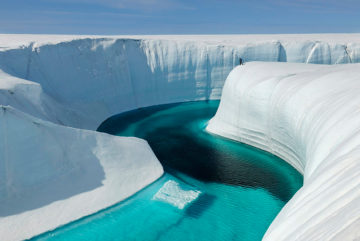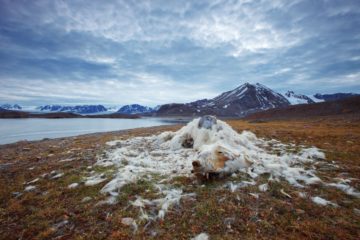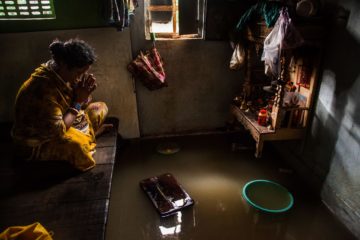Photographers play both an artistic and ethical role in society. With documentary images having the power to raise awareness of an intensely changing world, and with social media creating a platform for these messages to go viral, artists are pushing audiences to consider what we should be doing to help. Here we showcase four nature photographers that captured ‘transient’ natural environments that are facing the devastating effects of climate change.
The glaciers of Gokyo Lake in Khumbu Nepal might as well be on a different planet to the smoggy heat of a windy spring day in the Sydney CBD. Very different also to a small village in South Sudan, where climate extremes are elongating droughts and intensifying flooding. Elsewhere, a polar bear and her cub lie in a sand den in high arctic Alaska. The locals say it has been an unusually warm summer and the ice will form later than usual. Their coats are tinged brown from the sand.
Photography has always been a tool for capturing a transient moment in time, a fleeting image of resonance or beauty. With climate change, arctic ice has become one of the most drastically disappearing “moments” on our planet. Endangered animals and their natural habitats, oceanside villages and vibrant, unaltered forestation seem destined to become a distant memory. For these four nature photographers, the changing environment as a result of climate change has become a crucial subject of their artistic documentation.

Rae Begley, ‘AND NOTHING TURNED ITSELF INSIDE OUT’
Rae Begley is an Australian film photographer who documents the sheer scale and tranquillity of secluded locations, intimate environments and ephemeral moments of the every day. Her work documents the world, from the Himalayas to her local Sydney beaches. She’s been taking photographs since the late nineties and is inspired by the way in which an analogue photograph can produce a ‘painting out of light and film.’ But her current priority is highlighting the changing environments of secluded and beautiful landscapes as a result of climate change, and our impact on these spaces.
Her latest series ‘AND THEN NOTHING TURNED ITSELF INSIDE OUT’, photographed last year during a trip to the Khumbu regions in Nepal, was exhibited in early November and included a series of still, video and installation works that created an ‘immersive experience’ for the viewer. The works depict the fleetingly beautiful state of the lake Gokyo and the Ngozumpa glacier in its seemingly untouched environment. There is something visceral and melancholy in these photographs. Like nostalgic renditions of a time still to come, one in which the landscape has been completely altered. It is a beckoning yet peaceful depiction of the threat of climate change. Begley says that she wants to preserve these natural moments through photography ‘to become historical documents in the timeline of climate change.’
Rae Begley is donating a percentage of every one of her photographs purchased to the Ice Stupa Project online: a program that provides artificially designed glaciers ‘which store wasting winter water in the form of ice mountains that melt and feed the farms when water is most needed by the farmers.

James Balog, ‘Chasing Ice’
Expansive burrowing glaciers and naturally vibrant tinges of white and turquoise artic-scapes can be found in the work of American photographer and climate activist James Balog. His worldwide ‘extreme ice survey’ project that became a feature film titled Chasing Ice. Inspired by a project done with the National Geographic, Balog aimed to develop photographic evidence of the ‘glaciers and ice sheets that are retreating in various parts of the worlds as a consequence of climate change.’ The project accumulated a huge number of still photographic images of these glacial environments, but also developed a series of time lapse photographs that hopes to bring home the seriousness and drastic pace at which these ecosystems are collapsing from the pressure. As part of the program, time lapse tripods were set amongst the glaciers of Antarctica, Iceland, Greenland, Northern Canada and Alaska to produce far reaching and unarguable proof of the damage caused by climate change.
James Balog has been published in many of the world’s major pictorial magazines. His photographs have been seen in The New Yorker, National Geographic, Life, and Vanity Fair among others. His work aims to bring awareness to everyday people who are disconnected from the viewable affect of climate change. With major publicity and widespread recognition, Balog has been paving the way for climate documentation for a number of years and shows no sign of stopping any time soon.

Vadim Balakin, ‘Life and Death’
Russian nature photographer Vadim Balakin won first place in the environmental issues category of the 2016 Nature Photographer of the Year Awards for his photograph ‘Life and Death’ which documented the decomposition of a polar bear, who had died of starvation in the islands of Northern Svalbard in Norway. The unspoken causation clearly a loss of habitat and food sources that has defeated the powerful beast.
His work explores the relationships between animals and their environments as well as cycles of life in desolate and harsh icy environments like Antarctica and Norway. This focus has led Balakin to depict processes of change and decomposition that are being controlled and transformed by climate change.

Arka Dutta, Sudden Inundation
Arka Dutta’s photographs humanise the statistics and research of the science of climate change by featuring the ordinary lives of people living with the challenges caused by extreme conditions– flash flooding and drought to name a few. His series ‘’Sudden Inundation’ set in a village in central Kulkuta, shows the effects of annual flooding in the area. Houses are decimated and crops are destroyed, while villagers are forced to trudge through waste deep flood waters to reach shelter.
Arka Dutta says he ‘uses photography as a visual medium to address problems.’ His works span across portraiture, landscape and hybrids of the two, with a focus on individual stories and depictions of diversity around the world.
Culture and art has the power to impact societal change. But on an issue that still isn’t resonating globally and is flatly denied by conservative leaders, these photographers are using their visual skills to prove that seeing is believing.
What impact do you think art and culture has on society at large and can it change our behaviours for the better? Let us know your view in the comment section below.







